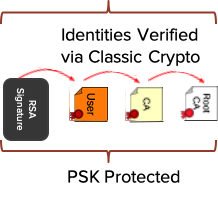Security
A Proposal for a Long-Term Post-Quantum Transitioning Strategy for the Broadband Industry via Composite Crypto and PQPs

The broadband industry has historically relied on public-key cryptography to provide secure and strong authentication across access networks and devices. In our environment, one of the most challenging issues—when it comes to cryptography—is to support devices with different capabilities. Some of these devices may or may not be fully (or even partially) upgradeable. This can be due to software limitations (e.g., firmware or applications cannot be securely updated) or hardware limitations (e.g., crypto accelerators or secure elements).
A Heterogeneous Ecosystem
When researching our transitioning strategy, we realized that—especially for constrained devices—the only option at our disposal was the use of pre-shared keys (PSKs) to allow for post-quantum safe authentications for the various identified use cases.
In a nutshell, our proposal combines the use of composite crypto, post-quantum algorithms and timely distributed PSKs to accommodate the coexistence of our main use cases: post-quantum capable devices, post-quantum validation capable devices and classic-only devices. In addition to providing a classification of the various types of devices based on their crypto capabilities to support the transition, we also looked at the use of composite crypto for the next-generation DOCSIS® PKI to allow the delivery of multi-algorithm support for the entire ecosystem: Elliptic Curve Digital Signature Algorithm (ECDSA) as a more efficient alternative to the current RSA algorithm, and a post-quantum algorithm (PQA) for providing long-term quantum-safe authentications. We devised a long-term transitioning strategy for allowing secure authentications in our heterogeneous ecosystem, in which new and old must coexist for a long time.
Three Classes of Devices
The history of broadband networks teaches us that we should expect devices that are deployed in DOCSIS® networks to be very long-lived (i.e., 20 or more years). This translates into the added requirement—for our environment—to identify strategies that allow for the different classes of devices to still perform secure authentications under the quantum threat. To better understand what is needed to protect the different types of devices, we classified them into three distinct categories based on their long-term cryptographic capabilities.
Classic-Only Devices. This class of devices does not provide any crypto-upgrade capability, except for supporting the composite crypto construct. For this class of devices, we envision deploying post-quantum PSKs (PQPs) to devices. These keys are left dormant until the quantum-safe protection is needed for the public-key algorithm.

Specifically, while the identity is still provided via classic signatures and associated certificate chains, the protection against quantum is provided via the pre-deployed PSKs. Various techniques have been identified to make sure these keys are randomly combined and updated while attached to the network: an attacker would be required to have access to the full history of the device traffic to be able to get access to the PSKs. This solution can be deployed today for cable modems and other fielded devices.
Quantum-Validation Capable Devices. This type of device does not provide the possibility to upgrade the secure storage or the private key algorithms, but their crypto libraries can be updated to support selected PQAs and quantum-safe key encapsulation mechanisms (KEMs). Devices with certificates issued under the original RSA infrastructure must still use the deployed PSKs to protect the full authentication chain, whereas devices whose credentials are issued under the new PKI need only protect the link between the signature and the device certificate. For these devices, PSKs can be transferred securely via quantum-resistant KEMs.
Quantum Capable Devices. These devices will have full PQA support (both for authentication and validation) and might support classic algorithms for validation. The use of composite crypto allows for validating the same entities across the quantum-threat hump, especially on the access network side. To validate classic-only devices, the use of Kerberos can address symmetric pairwise PSKs distribution for authentication and encryption.
Composite Crypto Solves a Fundamental Problem
In our proposal for a post-quantum transitioning strategy for the broadband industry, we identified the use of composite crypto and PQPs as the two necessary building blocks for enabling secure authentication for all PKI data (from digital certificates to revocation information).
When composite crypto and PQPs are deployed together, the proposed architecture allows for secure authentication across different classes of devices (i.e., post-quantum and classic), lowers the costs of transitioning to quantum-safe algorithms by requiring the support of a single infrastructure (also required for indirect authentication data like “stapled” OCSP responses), extends the lifetime of classic devices across the quantum hump and does not require protocol changes (even proprietary ones) as the two-certificate solution would require.
Ultimately, the use of composite crypto efficiently solves the fundamental problem of associating both classic and quantum-safe algorithms to a single identity.
To learn more, watch SCTE Tec-Expo 2020’s “Evolving Security Tools: Advances in Identity Management, Crytography & Secure Processing” recording and participate to the KeyFactor’s 2020 Summit.




